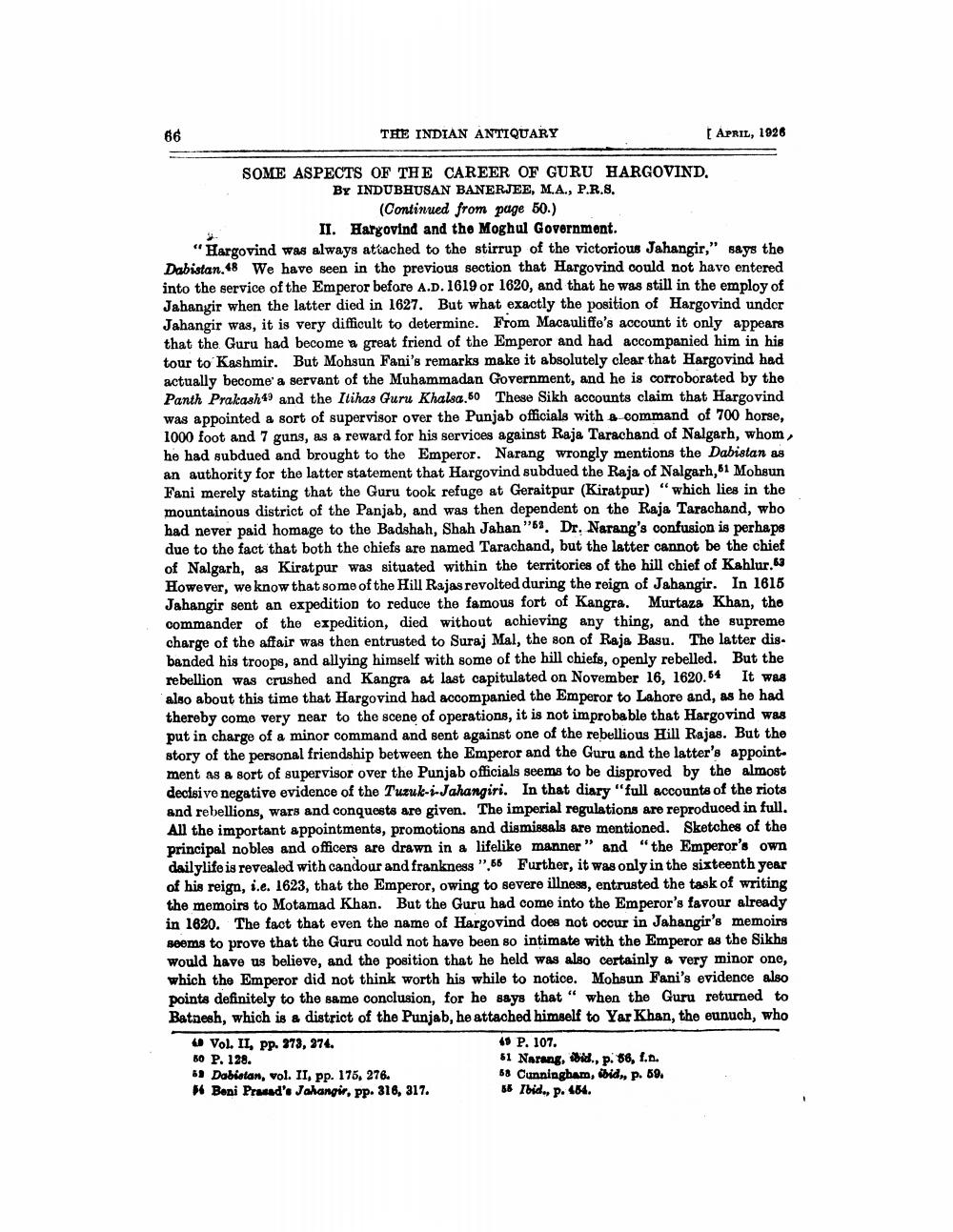________________
66
Vol. II, pp. 273, 274.
THE INDIAN ANTIQUARY
SOME ASPECTS OF THE CAREER OF GURU HARGOVIND. BY INDUBHUSAN BANERJEE, M.A., P.R.S. (Continued from page 50.)
II.
Hargovind and the Moghul Government.
"Hargovind was always attached to the stirrup of the victorious Jahangir," says the Dabistan.48 We have seen in the previous section that Hargovind could not have entered into the service of the Emperor before A.D. 1619 or 1620, and that he was still in the employ of Jahangir when the latter died in 1627. But what exactly the position of Hargovind under Jahangir was, it is very difficult to determine. From Macauliffe's account it only appears that the Guru had become a great friend of the Emperor and had accompanied him in his tour to Kashmir. But Mohsun Fani's remarks make it absolutely clear that Hargovind had actually become a servant of the Muhammadan Government, and he is corroborated by the Panth Prakash49 and the Itihas Guru Khalsa.50 These Sikh accounts claim that Hargovind was appointed a sort of supervisor over the Punjab officials with a command of 700 horse, 1000 foot and 7 guns, as a reward for his services against Raja Tarachand of Nalgarh, whom, he had subdued and brought to the Emperor. Narang wrongly mentions the Dabistan as an authority for the latter statement that Hargovind subdued the Raja of Nalgarh,61 Mohsun Fani merely stating that the Guru took refuge at Geraitpur (Kiratpur) "which lies in the mountainous district of the Panjab, and was then dependent on the Raja Tarachand, who had never paid homage to the Badshah, Shah Jahan "63. Dr. Narang's confusion is perhaps due to the fact that both the chiefs are named Tarachand, but the latter cannot be the chief of Nalgarh, as Kiratpur was situated within the territories of the hill chief of Kahlur.63 However, we know that some of the Hill Rajas revolted during the reign of Jahangir. In 1615 Jahangir sent an expedition to reduce the famous fort of Kangra. Murtaza Khan, the commander of the expedition, died without achieving any thing, and the supreme charge of the affair was then entrusted to Suraj Mal, the son of Raja Basu. The latter disbanded his troops, and allying himself with some of the hill chiefs, openly rebelled. But the rebellion was crushed and Kangra at last capitulated on November 16, 1620.54 It was also about this time that Hargovind had accompanied the Emperor to Lahore and, as he had thereby come very near to the scene of operations, it is not improbable that Hargovind was put in charge of a minor command and sent against one of the rebellious Hill Rajas. But the story of the personal friendship between the Emperor and the Guru and the latter's appoint. ment as a sort of supervisor over the Punjab officials seems to be disproved by the almost decisive negative evidence of the Tuzuk-i-Jahangiri. In that diary "full accounts of the riots and rebellions, wars and conquests are given. The imperial regulations are reproduced in full. All the important appointments, promotions and dismissals are mentioned. Sketches of the principal nobles and officers are drawn in a lifelike manner" and "the Emperor's own dailylife is revealed with candour and frankness",66 Further, it was only in the sixteenth year of his reign, i.e. 1623, that the Emperor, owing to severe illness, entrusted the task of writing the memoirs to Motamad Khan. But the Guru had come into the Emperor's favour already in 1820. The fact that even the name of Hargovind does not occur in Jahangir's memoirs seems to prove that the Guru could not have been so intimate with the Emperor as the Sikhs would have us believe, and the position that he held was also certainly a very minor one, which the Emperor did not think worth his while to notice. Mohsun Fani's evidence also points definitely to the same conclusion, for he says that" when the Guru returned to Batnesh, which is a district of the Punjab, he attached himself to Yar Khan, the eunuch, who
50 P. 128.
59 Dabistan, vol. II, pp. 175, 276.
$6 Beni Prasad's Jahangir, pp. 316, 317.
[APRIL, 1926
45 P. 107.
51 Narang, bid., p. 56, f.n.
58 Cunningham, ibid,, p. 59.
55 Ibid., p. 454.




